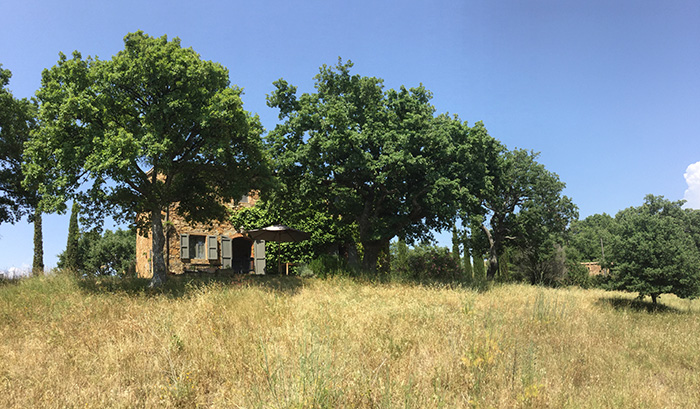| |
|
| |
|
|
|
|
|
|
| |
 |
|
N L I T
|
Castiglioncello Bandini
|
|
 |
 |
| |
|
|
|
| |
|
Castiglioncello Bandini
|
The fraction of Castiglioncello Bandini belongs to the municipality of Cinigiano, in the province of Grosseto, in Tuscany. Castiglioncello Bandini is situated in the eastern part of Cinigiano, at the foot of Poggio all'Olmo Nature Reserve.
|
|
|
|
| |
|
Of the castles that are situated in the Commune of Cinigiano, Castiglioncello Bandini, also called Stribugliano, is situated near the river Melacce in the valley of the Ombrone. Originally part of the holdings of the family Aldobrandeschi, over the centuries it frequently changed ownership: first Ranieri Giamboni, then the lords of Montorgiali, then the Abbey of Monte Amiata and finally the Piccolomini Bandini of Siena. It is currently privately owned. Of the original castle, recently reconstructed, there remains the round tower with sloping base that stands out in the highest part of the town. The castle underwent several operations for the amendment and restoration, particularly in the sixteenth century, and between the nineteenth and early twentieth when it was renovated in large part neomedievale style.
The internal church dedicated to San Nicola and medieval, had a replacement in the Baroque period.
Podere Santa Pia is situated in the valley below Castiglioncello Bandini. The main house is spacious, comfortable and well furnished and offers its guests a breathtaking view over the Maremma hills. This is still a place of wide-open spaces and the perfect destination for walking & hiking. A trail that leads to Cinigiano starts at Podere Santa Pia, passes the ruins of Podere Federano, where the stunning landscape of the Tuscan Maremma opens up, and ends at La Cantina, on Via Grosseto, Cinigiano.
The trial is characterized by olive groves, vineyards and macchia vegetation dominated by holm oak and downy oak.
Walking in Tuscany | From Podere Santa Pia (Castiglioncello Bandini) to Cinigiano
 Forecasts and weather Forecasts and weather
|
|
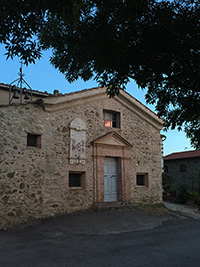 La Chiesa del Madonnino in La Chiesa del Madonnino in
Castiglioncello Bandini
|

Castiglioncello Bandini album
|
|
|
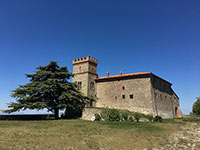 |
|
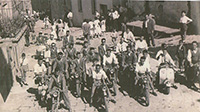 |
|
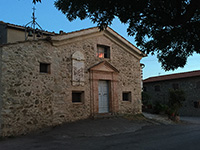 |
Castiglioncello Bandini, Castiglion del Torto
|
|
Castiglioncello Bandini |
|
La Chiesa del Madonnino in Castiglioncello Bandini |
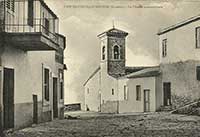 |
|
 |
|
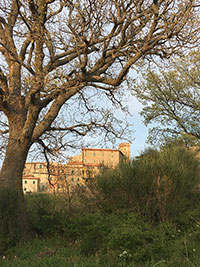 |
La chiesa di San Nicola, cartolina postale
|
|
La chiesa di San Nicola, Castiglioncello Bandini
|
|
Castiglioncello Bandini, castello |
Honey bees in Tuscany
|
|
|
Do you have a tree with some bees and you want to capture them? This video shows you how a bee keeper removes a large swarm of bees.
Bees are an important part of the natural environment and we should protect and save them. Each and every swarm presents an excellent opportunity for us to help the bees. The countryside of the Tuscan Maremma is one of the most beautiful settings that nature can offer. In the countryside exists a rich heritage of beekeeping and honey production. Swarming bees are a fascinating and natural part of the life cycle of honey bees. Swarming is the process by which a new honey bee colony is formed when the queen bee leaves the colony with a large group of worker bees.
What should you do if you see a swarm?
Swarms are valuable to beekeepers because they can be used to start new hives. Bees in a swarm are generally very healthy, so calling a beekeeper is probably the best thing to do.
Emanuel M., a beekeeper in Castiglioncello Bandini, Tuscany, shows how to catch a swarm.
|
|
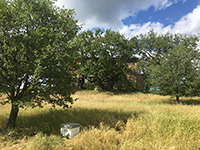
Catching a swarm of bees in Tuscany |
|
Enlarge map |
| |
The territory of Cinigiano, which stretches from the plains of the Maremma to the slopes of Mount Amiata, is very varied: the Mediterranean maquis alternates to olive groves and vineyards, fruit trees to green hills and chestnut trees.
The Olivastra Seggianese grows at 350-600 meters on the north-western foothills of Monte Amiata. This indigenous variety of olive tree was presumably introduced by monks from the nearby monastery San Salvatore in the early Middle Ages.
There are probably hundreds of majestic and magnificent trees in Monte Amiata area. Some of the most impressive trees are to be found near Podere Santa Margerita and Podere Santa Pia in Castiglioncello Bandini. The ancient trees grow in wondrous, tangled ways, with trunks resembling characters in fairy tales. These ancient trees have witnessed thousands of years of political unrest, plagues, diseases, varying climatic conditions and changing civilizations.
|
|


Olivastra Seggianese
|
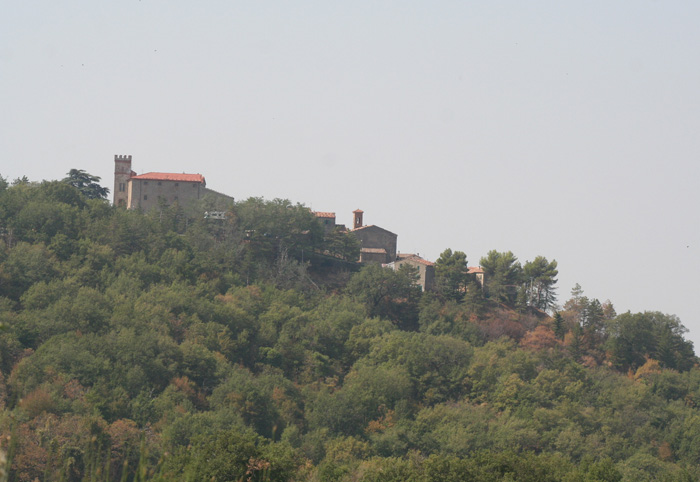 Castiglioncello Bandini, view from the cemetery Castiglioncello Bandini, view from the cemetery
|
Cinigiano
|
|
|
Cinigiano is definitely one of the most fascinating and enchanting location of Alta Maremma, seen as a small but wonderful ancient village.
Cinigiano rises on a hill west of the massif of Mount Amiata. It is a quiet village bordering the plains of Maremma. Cinigiano is shaped like a fortified village and preserves part of the walls and remains of the ancient fortress.
Thanks to the success of the red DOC wine Montecucco, Cinigiano has become a very lively village. We especially recommend Calici sotto le Stelle, literally wine glasses under the stars, on August 10, the night of Saint Lorenzo and of shooting stars, when cellars are opened to the public.
To the community of Cinigiano belong the frazioni Borgo Santa Rita (7 km), La Cava (7 km), Le Cosole (7 km), Monticello Amiata (10 km), Piantaverna (20 km), Poggi del Sasso (8 km), Porrona (3 km), Sasso d`Ombrone (9 km), Villa (6 km), Volpaio (7 km) and Castiglioncello Bandini (8 km).
Restaurants in Cinigiano and surroundings |
|
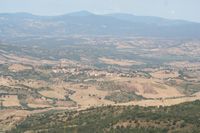
Cinigiano, , view from Castiglioncello Bandini
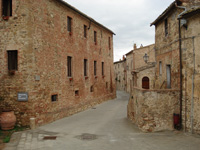
Cinigiano
|
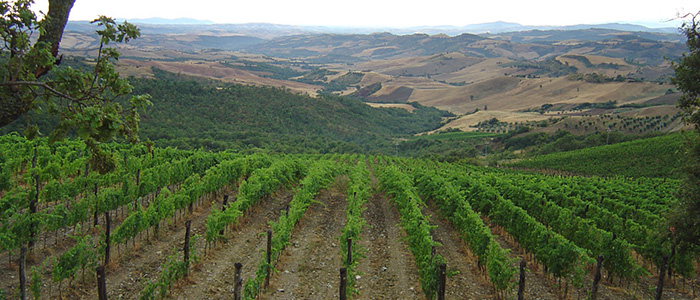 |
Montecucco vineyards at Castiglioncello Bandini
|
|
|
|
| |
|
Monticello Amiata
|
|
Monticello Amiata, ensconced behind its walls, stands on the top of a hill, watching over all Maremma and surrounding valleys
|
Along the road leading to Monte Amiata, still within the territory of Cinigiano, one finds the ancient village of Monticello Amiata.
The village was originally dominated by Monte Pinzutolo and is situated on a high hill, surrounded by a striking chestnut tree wood, and overlooks the valley of the Ombrone River. The walls enclosing the castle have retained their elliptical shape and are still visible, although many homes have been built over them. In addition, three protruding towers and two gateways are still preserved: the Monticelli gate and the gate of San Francesco.
The Parish church San Michele Arcangelo, looms over the village buildings and the colourful houses, separated by narrow alleys. The church of the patron saint of Monticello Amiata, stands in the centre of the village and preserves a superb painting La Madonna col Bambino by the Sienese artist Bartolomeo Neroni, a student of Sodoma, one of the most well known artists of 16th-century Italy.
On the outskirts of the town rises the church of Madonna di Val di Prata (1218), an ancient Marian sanctuary surrounded by a lovely park, in which are kept important works of art such as the altar-piece (1691) attributed to Nicola Nasini.
In Ripe the Cappella della Madonna del Lampino.
Casa Museo is a small ethnographic museum located in an old oilmill. The exhibition reveals many aspects of daily life, economy and folklore of the 18th and 19th centuries through a series of items, tools and reconstructions of domestic environments. The oil press with its huge millstone and the tools for chestnut processing are particularly interesting.
www.museidimaremma.it | Casa Museo
The Museums of Maremma | Monticello Amiata - Museum House
Do not miss the Festa della Castagna and the Festa dell'Olio: Monticello dedicates the second Sunday of October to the chestnut harvest and the last Sunday of November to the new olive oil.
|
|
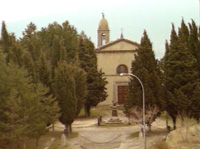 Madonna di Val di Prata (1218) Madonna di Val di Prata (1218)
|
Stribugliano
|
|
|
Stribugliano is about 6 km from Castiglioncello Bandini, situated on a peak of Monte Buceto above the valley of Melacce, between Castiglioncello Bandini and Roccalbegna.
Stribugliano is a takeoff in front of Monte Buceto for hang gliding and paragliding. The takeoff tilts gradually allowing for easy takeoff, both single and tandem. Recently a south takeoff has been discovered, however locals recommend only using western takeoff.
You can reach the top of Monte Buceto and the Takeoffby car or in a one/two hour walk through easy paths and, from there, enjoy a great view over the ombre Valley. Turn right just beond Stribugliano.
Paragliding sites in Italy - Stribugliano | MAP
Informazion weather forecast, wind directions, wind speed | www.paraglidingmap.com
|
|
|
Fondazione Bertarelli di Poggio del Sasso
|
|
|
| La Fondazione Bertarelli costituita per iniziativa dei fratelli, Maria Iris Tipa Bertarelli e Claudio Tipa, vice presidente della Fondazione Bertarelli e proprietario, nel territorio del Brunello, della cantina Poggio di Sotto. La Fondazione Bertarelli è operativa dal 2009 e si occupa statutariamente della promozione del territorio della Toscana mediante contributi nel mondo dell'arte, del recupero ambientale, dell'archeologia, dell'architettura contemporanea sostenibile. Ad oggi la fondazione ha partecipato alla programmazione ed ha fornito sostegno economico a numerosi progetti tra cui quelli socio-sanitari svolti dalla confraternita della Misericordia di Cinigiano e quelli artistici dell'Amiata Piano Festival.
La Fondazione Bertarelli è il principale sponsor di Amiata Piano Festival.
Amiata Piano Festival
Fondato e diretto da Maurizio Baglini, Amiata Piano Festival è sostenuto dalla Fondazione Bertarelli. Il Forum Fondazione Bertarelli si trova in una posizione panoramica unica, circondato dai vigneti e dagli uliveti della Cantina Collemassari di proprietà della famiglia Bertarelli – Tipa.
Forum Fondazione Bertarelli
|
|
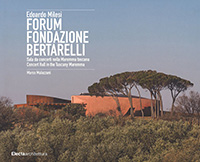 |
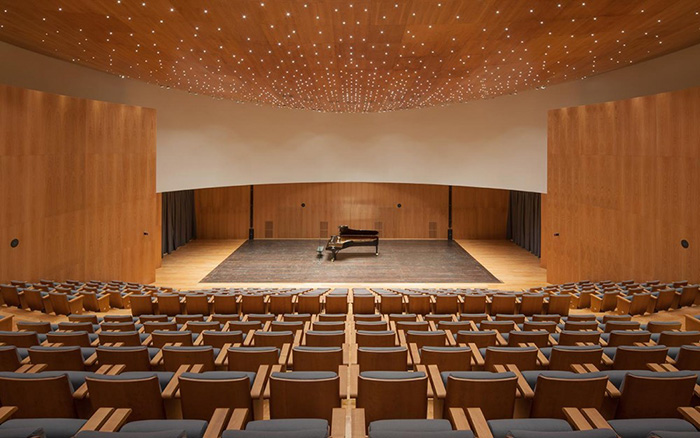 |
| Forum Fondazione Bertarelli, interior forum[1]
|
Il Forum Fondazione Bertarelli è un gioiello di acustica circondato da vigneti a perdita d’occhio, che ospiterà musica da camera, ma anche sinfonica, jazz e pop. l’auditorium è incastonato in un contesto ambientale suggestivo, nella zona di Poggi del Sasso, Cinigiano, nel cuore della Maremma Grossetana.
Progettato dallo studio Edoardo Milesi & Archos, l’auditorium si trova a Poggi del Sasso, Cinigiano, Grosseto, nelle immediate vicinanze delle precedenti sedi del festival: la sala da musica San Giuseppe e la Cantina di ColleMassari (la prima verrà d’ora in poi utilizzata per registrazioni discografiche, la seconda sarà visitabile su prenotazione).
Forum Fondazione Bertarelli
Programma | www.amiatapianofestival.com
Come arrivare: Dalla statale SS223 / E78 Grosseto – Siena uscire a Paganico e attraversare il paese in direzione Monte Amiata. Dopo 4 km girare a destra per Sasso d’Ombrone. Dopo il paese, al primo bivio girare a destra seguendo le indicazioni per Poggi del Sasso. Attraversare il paese e proseguire sulla strada principale per circa 4 km (lungo il percorso, a metà strada sulla destra, si trova la Cantina di ColleMassari); poi imboccare la strada a sinistra che conduce direttamente al Forum Fondazione Bertarelli.
Da Podere Santa Pia,
attraversare il paese in direzione Cinigiano, e puoi Paganico. Prima di arrivare a Sasso d'Ombrone, girare a sinistra seguendo le indicazioni per Poggi del Sasso. Attraversare il paese e proseguire sulla strada principale per circa 4 km (lungo il percorso, a metà strada sulla destra, si trova la Cantina di ColleMassari); poi imboccare la strada a sinistra che conduce direttamente al Forum Fondazione Bertarelli. Più informazione e mappa.
Marco Mulazzani, R. Sadleir (Traduttore), Edoardo Milesi. Forum Fondazione Bertarelli. Sala da concerti nella Maremma toscana-Concert Hall in the Tuscany Maremma, Mondadori Electa, 2015, ISBN-10: 8891801712 — ISBN-13: 978-8891801715
"La forma ovoidale della costruzione è generata dalla sala interna, nella quale sono immersi e avvolti dal suono l'orchestra e il pubblico, ma risponde anche al desiderio di non introdurre cesure nella continuità dei profili delle colline, nelle distese di ulivi e di pini che le contrappuntano. Una parete curva sul fianco esterno, verso ovest, definisce il percorso di accesso al foyer, nascondendo progressivamente alla vista lo spettacolo della natura e preparando allo spettacolo che si svolge all'interno, i materiali utilizzati sono solo di tre tipi: il calcestruzzo scabro, del colore della terra, per il guscio della costruzione; l'acciaio corten ossidato naturalmente e il vetro per le superfici trasparenti che consentono di percepire dal foyer gli ultimi suggestivi scorci del paesaggio, prima di entrare nella sala. Il volume illustra con dovizia di documenti grafici e fotografie il progetto e il cantiere della Concert Hall, caratterizzata da soluzioni tecnico-costruttive di grande interesse. Il testo di Marco Mulazzani ne ricostruisce la genesi, restituendo il quadro dell'attività svolta da Edoardo Milesi in questi luoghi negli ultimi quindici anni e ne analizza le caratteristiche e gli esiti architettonici; un ampio reportage fotografico testimonia l'inserimento dell'opera nel paesaggio maremmano."
See also Wine and architecture in Tuscany
|
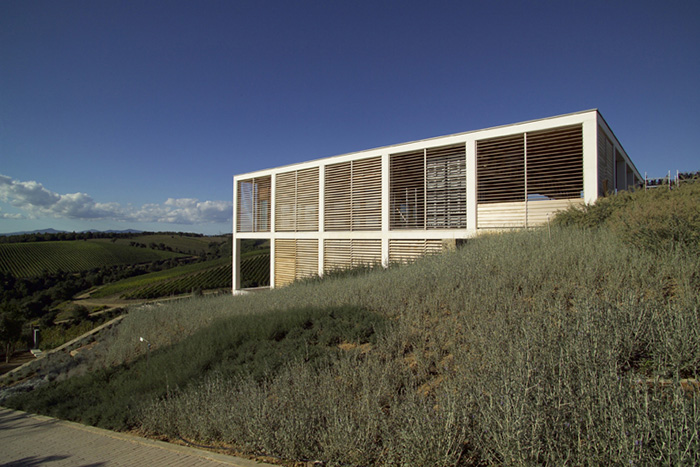 |
Cantina ColleMassari. Foto da Paolo Da Re
|
In 2011, Claudio Tipa, owner of ColleMassari and Grattamacco, bought Poggio di Sotto from Piero Palmucci. Poggio di Sotto is situated just outside the town of Castelnuovo dell'Abate in the southern part of Montalcino. Poggio di Sotto produces wines of rare elegance and subtlety for this part of the Brunello di Montalcino zone.
|
| |
|
|
| |
|
| |
|
|
|
|
| |
|
|
Holiday accomodation | Podere Santa Pia, hidden in the valley between Castiglioncello Bandini and Cinigiano
|
| |
|
|
|
|
Sallustio Antonio Bandini (1677-1760)
|
|
|
Sallustio Antonio Bandini, was a priest, farmer and writer (Siena 1677 - therein 1760), and the founder of the Library of Siena. In Discorso sopra la maremma di Siena (1735) Bandini pointed out the contrast between city and countryside and the inability of the Medici government to implement a policy of wheat that could lift the condition of the poor areas.
His monument, a work of Tito Sarrocchi, stands in the Piazza dei Salimbeni in front of the Banca Monte dei Paschi, the oldest surviving bank in the world.
Read more (it) | Mario Mirri, BANDINI, Sallustio Antonio, Dizionario Biografico degli Italiani - Volume 5 (1963) | www.treccani.it
|
|
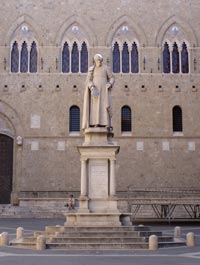
Monument for Sallustio Antonio Bandini in Siena, Piazza dei Salimbeni
|
| |
|
|
 |
Cicloturismo in Maremma | I tre passi | The Three Passes - 30.7 km
ARCIDOSSO - MONTELATERONE - BIVIO MONTICELLO AMIATA - LOCALITÀ ALTETA - BIVIO MONTE AQUILAIA - VALICO BUCETO - BIVIO MONTE LABBRO - LOCALITÀ MERIGAR - LOCALITÀ AIOLE - ARCIDOSSO
Verso le sorgenti dell’Albegna
ARCIDOSSO - LE MACCHIE - BIVIO BUCETO - ROCCALBEGNA - RISERVA DEL PESCINELLO - BIVIO MONTE LABBRO - LOCALITÀ AIOLE - ARCIDOSSO
|

Monte Amiate is the highest Tuscan mountain (1739 metres). The Monte Aviate area covers 11 villages as well as the mountains Labbro (1193), Buceto (1152), Civitella (1107) and Paggio Zoccolino (1035). A network of approximately 19 main routes and many side paths are spread over 200 kilometres of unique discovery tours.
Walking in southern Tuscany | Itineraries exploring Castiglioncello Bandini and the Mediterranean macchia in the valleys around the village
Brief itinerary exploring the Mediterranean macchia and calanchi in the valley between Podere Santa Pia and Cinigiano
Circular Trail | Starting Point, the cypresses of Podere Santa Pia
Lenghth: 3,85 km, 1 hour 20 minutes
Easy, except for the track halfway
Through the woods to Castiglioncello Bandini
Starting Point, the cypresses of Podere Santa Pia or the Castle of Castiglioncello Bandini
Lenghth: 6 km, 1 hour 55 minutes
Easy | 227 m upwards, 227 m downwards
From Podere Santa Pia (Castiglioncello Bandini) to Cinigiano
Lenghth: 8,34 km
Easy
Hiking along the Rancioa riverbed, in the hidden valleys below Castiglioncello Bandini
Circular Trail | Starting Point, the cypresses of Podere Santa Pia
Lenghth: 4,42 km, 1 hour 31 minutes
Easy, except for the essential part of the track beyond Podere Federano, where you reach and follow the Rancioa riverbed
|
The paths of Monticello Amiata | 14 km
|
Various itineraries offer an opportunity to explore the hills at the feet of the western side of Mount Amiata. Choose between a ring north of the town (3.5km), a path that crosses the valley of the Zancono River to arrive at Montelaterone (3.5km), and one that circles Poggio Materaio and arrives at Salaiola (7km).
|
The ring of Cinigiano and Castiglioncello Bandini| 21 km
|
A long ring mostly along a gravel road, along the hills at the foot of the western side of Monte Amiata. It heads north towards Porrone and Poggio Campi Bui, then thurns south on a large crest crossing the road from Cinigiano to Monticello Amiata. On the return the path crosses the valley of the Melacce River.
|
The Olivastra di Seggiano
|
The Olivastra di Seggiano is an indigenous botanical species found throughout the area of Monte Amiata. This cultivar is above all found in the Province of Grosseto growing between 200 and 650 meters above sea level and concentrated particularly around Seggiano.
This indigenous variety of olive tree was presumably introduced by monks from the nearby monastery San Salvatore in the early Middle Ages. Already in the 10th century, the abbot of this monastery mentioned Seggiano as a production region of fine olive oil. The Olivastra Seggianese is largely climate-resistant and thus perfectly adapted for the altitude, which is unusually high for olive trees.
Characterized by its ample, rich foliage, the Olivastra is distinguished by the small size and the peculiar colour of its fruits, which are purple-red during the growing phase and black at the maturation stage. Growing high above sea level, it matures earlier compared to other olive oil tree species, whilst instead, it comes into production only after fifteen years.
The plant comes from a particularly robust rootstock: a mountain variety which is well able to resist the low winter temperatures, and this cazracteristic also acts as a natural deterrent to parasitic infestations.
If it happens to be neglected, it tends to get wild and even forms thorny branches: the cultivar is in fact descended from Olea Europea Silvestris, a form posterior to the wild cultivated olive.
There are probably hundreds of majestic and magnificent trees in Monte Amiata area. Some of the most impressive trees are to be found near Podere Santa Margerita and Podere Santa Pia in Castiglioncello Bandini.
The "Consorzio Olio di Seggiano" was founded in 2002 under the spur of a group of local entrepreneurs dedicated to the production of the extra-virgin olive oil from the processing of the local cultivar, the Olivastra di Seggiano. The association was formed in order to improve its quality and its characteristics, by promoting the adherence to a code of conduct for local producers.
In fact, this particular sort of olive oil presents many characteristics which continue to be preserved: a particularly hardy and wild cultivar, which grows on the slopes of Monte Amiata in secular olive groves ranging up to 600 meters over the sea level.
The flora and fauna present particular ecotypes which combine to make the territory unique: the mountain's slopes are wreathed with beech, chestnuts and pine forests, home to rare species, such as the short-toe eagle, the Egyptian vulture, the Lanner falcon and the wolf, as well as many other more common mammals and birds of pray. Various protected areas of the local environment have been created, which operate hand in hand with institutions for study and development to research and communicate information about the natural beauty of the territory.
The area of production of Consorzio di Seggiano extends over the municipalities of Arcidosso, Castel del Piano, Seggiano, Cinigiano, Santa Fiora, Roccalbegna, Semproniano and parts of Castell'Azzara's territory.
The Consorzio - Consorzio Olio di Seggiano
|
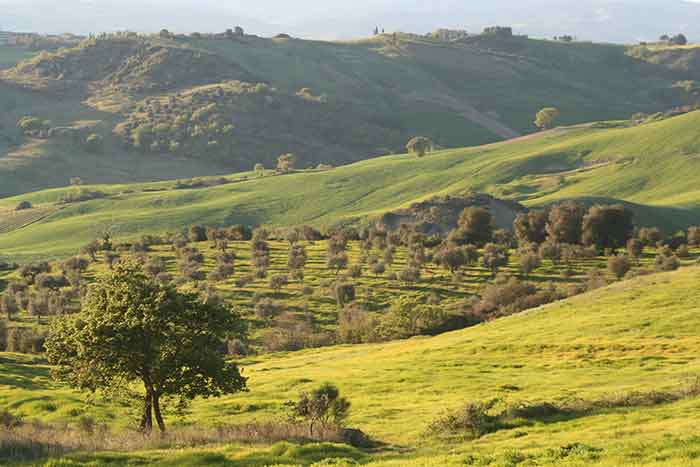 |
Some of the most impressive examples of the Olivastra di Seggianoare to be found near Podere Santa Margerita and Podere Santa Pia in Castiglioncello Bandini.
|
|
Restaurants in Cinigiano, Santa Rita, La Cava, Le Cosole, Monticello Ami ata, Piantaverna, Poggi del Sasso, Porrona, Sasso d`Ombrone , Villa, Volpaio and Castiglioncello Bandini
|
La Rosa dei Venti | Castiglioncello Bandinin, outstanding pizze on Saturday.
|
Casa Bianca | Viale Giuseppe Mazzini, Sasso d'Ombrone | Tel 0564.990593, mail: casabianca2004@libero.it
|
Locanda La Posta | Via Roma 2 | Telefono 0564.993430 | Closed on Wednesday.
|
Il Lucherino | Località Lucherino, Monticello Amiata | Telefono 0564.992975, mail: meichini@tiscali.it
|
ll Riccio | Via Amiata 28, Monticello Amiata | Telefono 0564.992004.
|
Il Rintocco | Piazza Marconi 4, Cinigiano | Tel 0564.994120 | www.ilrintocco.it
One of the best in the region.
|
Sotto l’insegna della luna piena | Via Amiata 3, Monticello Amiata | Tel 0564.992918, mail: sottoluna@tiscali.it | Closed on Monday
|
Trattoria Il Cinghiale | Poggi del Sasso www.sottoluna.itTel 0564.990428 | Closed on Tuesday.
|
Il Villaggio | Loc. Borgo Santa Rita | Tel 0564.99056.
|

Holiday accomodation | Podere Santa Pia, hidden in the valley between Castiglioncello Bandini and Cinigiano. The formal cloister is a perfect holiday house with breathtaking views on the Maremma. The most interesting artistic, historical and cultural sites of southern Tuscany are nearby, and are awaiting your discovery.
|

[1] Source: Edoardo Milesi architetto e ARCHOS, studio di architettura e casa editrice Albino Bergamo Italy| www.archos.it |
| |
|
|
| |
|
|
|
| |
|
|
|
| |
|
|
|
| |
|
|
|
| |
|
|
|
| |
|
|
|








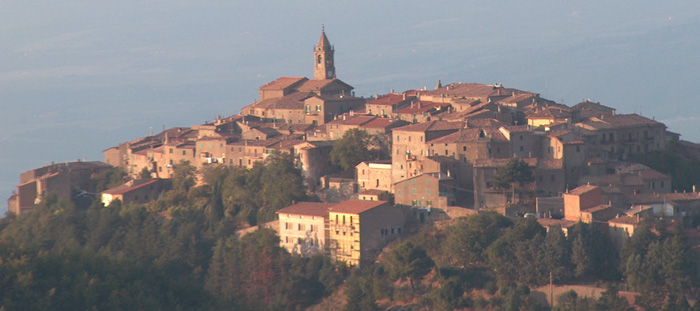





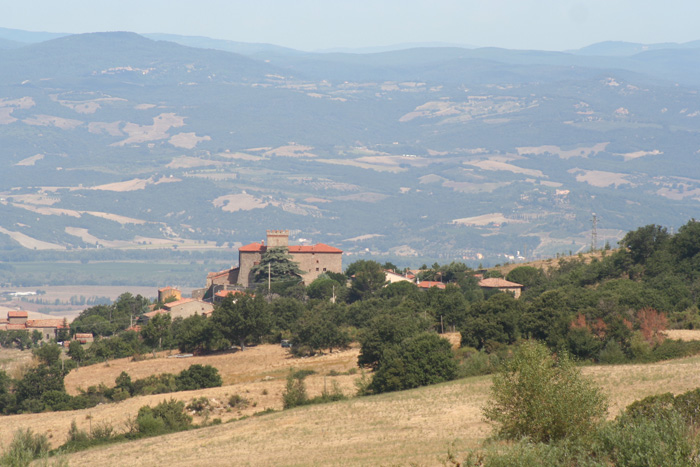




 Castiglioncello Bandini
Castiglioncello Bandini


